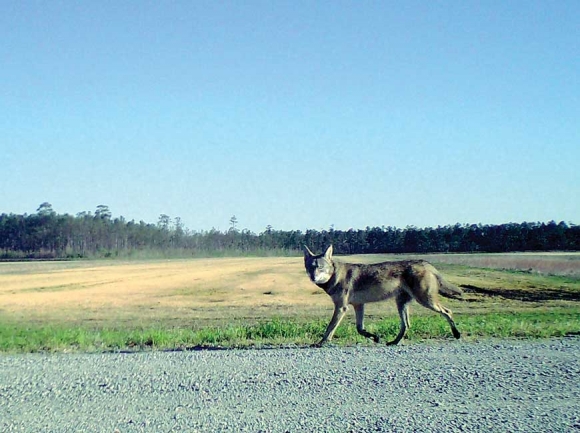Red wolf status grim, review says
 A red wolf walks along a roadside in eastern North Carolina. Donated photo
A red wolf walks along a roadside in eastern North Carolina. Donated photo
A five-year red wolf status review, released April 24, showed that only about 40 red wolves are left in the wild with only three known breeding pairs remaining.
The review, released by the U.S. Fish and Wildlife Service, recommends no change in the red wolf’s status as endangered under the Endangered Species Act. The USFWS is expected to release a new proposed rule by late summer with alternatives for public comment covering future management of the “non-essential, experimental population” of red wolves in eastern North Carolina.
“Currently, the NEP (non-essential, experimental population) is declining more rapidly than the worst-case scenarios … it is obvious that there are significant threats to the NEP in eastern North Carolina and conditions for recovery of the species are not favorable and a self-sustainable population may not be possible,” the review reads.
In September 2016, the USFWS announced that red wolves would be removed from the majority of the five-county area of eastern North Carolina where they’d been reintroduced. The move followed nearly two years of evaluating the feasibility of reintroduction efforts, and a lawsuit in which environmental groups claimed the USFWS was not doing enough to protect the wolves. Reintroduction was once attempted in the Smokies, but failed.
The nonprofit Wildlands Network has issued a statement expressing its disappointment with the review, even as it supports the decision to keep red wolves protected under the Endangered Species Act.
“We’re disappointed that the five-year status review appears to take great pains to describe the North Carolina wild population of red wolves as unsustainable, without acknowledging the fact that the decision by FWS leadership to functionally abandon the program is what has led to the striking recent declines in red wolf numbers since 2012,” said Ron Sutherland, conservation scientist for Wildlands Network. “They stopped releasing new wolves from captivity, they stopped managing coyotes, and they’ve sat back and watched as gunshot mortality shredded the red wolf population.”
However, the report does state that the agency will look for other places in the United States to reintroduce the red wolf — just not in eastern North Carolina.
“Our goal is to build a network of partnerships that will work together to establish recovery goals, an implementation plan and execute on the groundwork to reach the jointly-established recovery goals for the red wolf,” the review reads. “The red wolf remains a conservation-reliant species. While its genetic viability can be managed through the captive population, there is little chance of a naturally occurring wild population existing without active management.”





